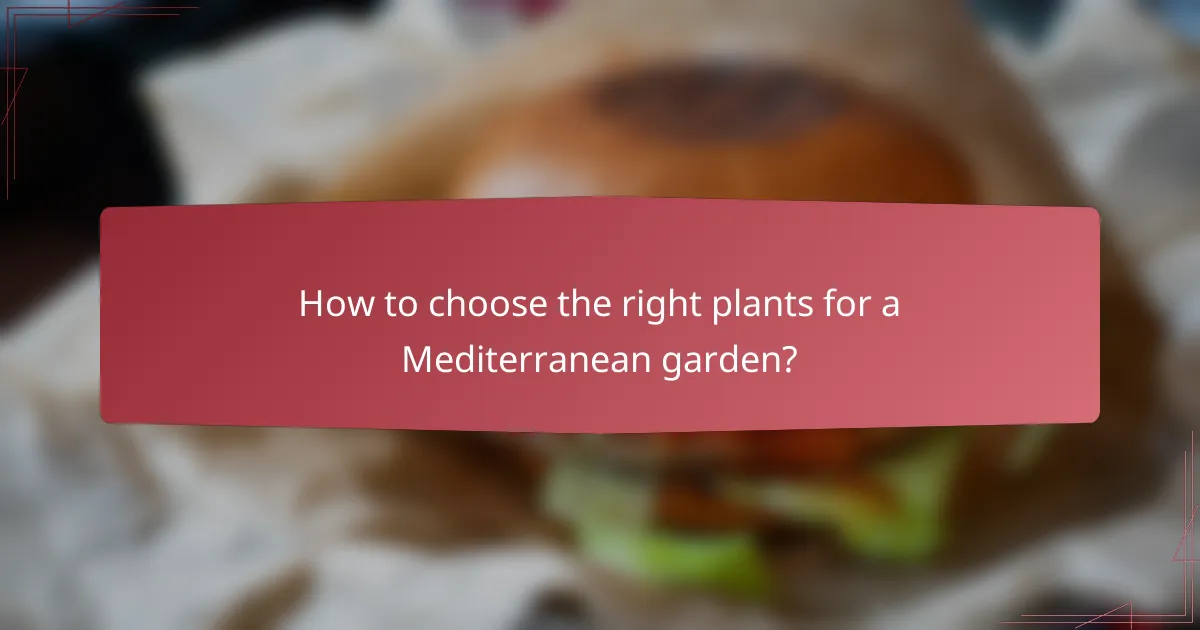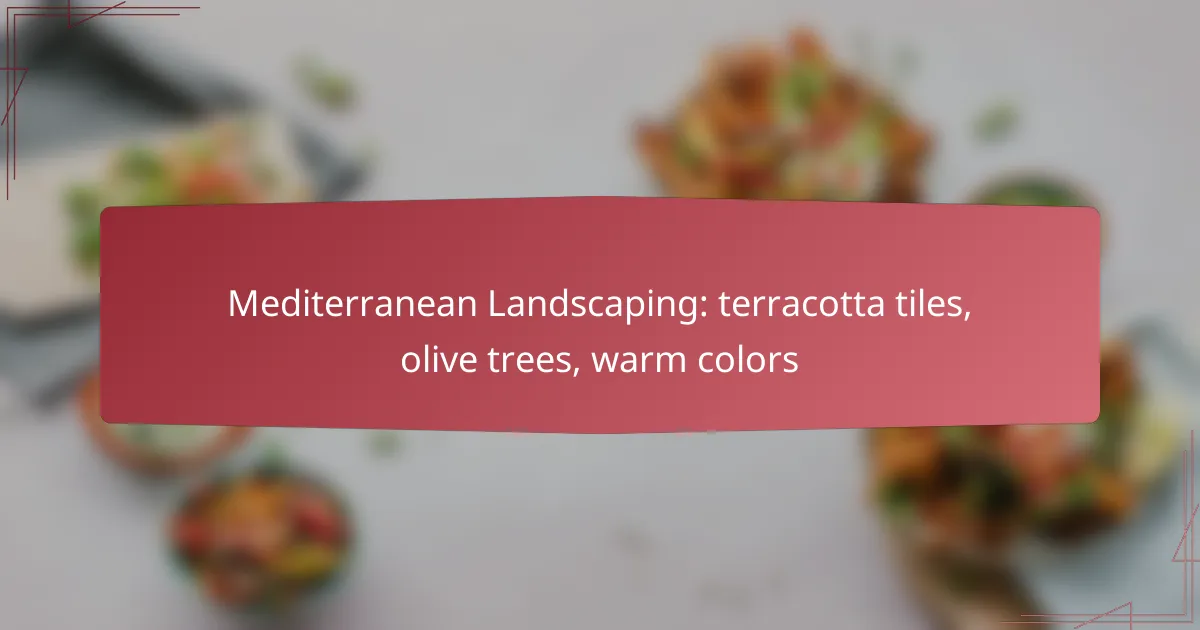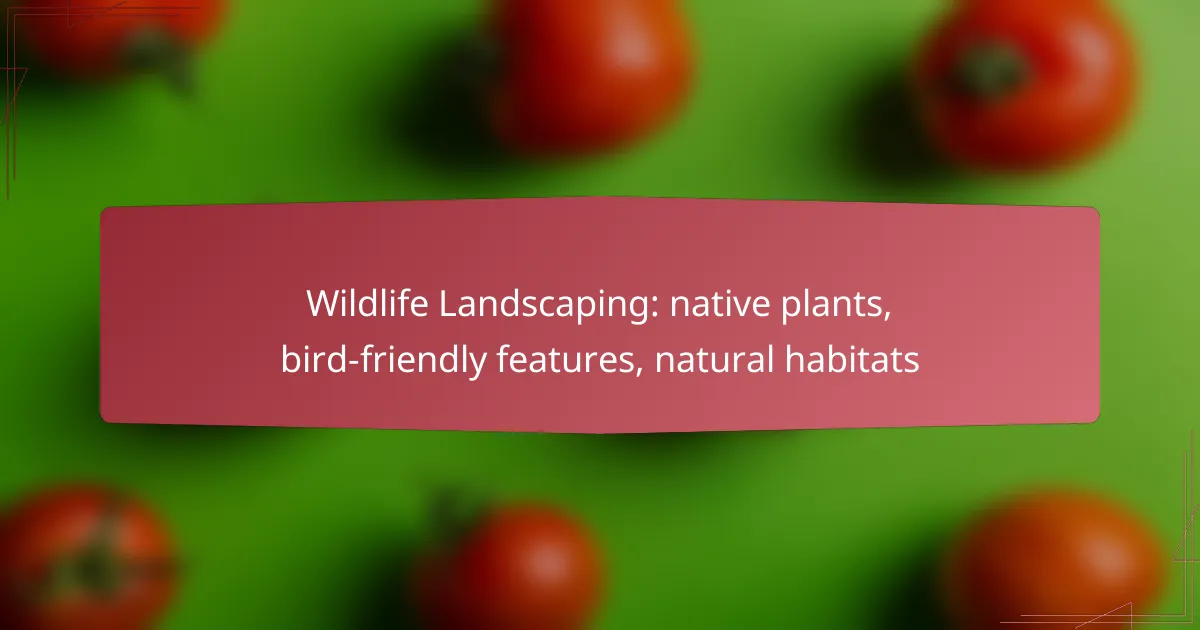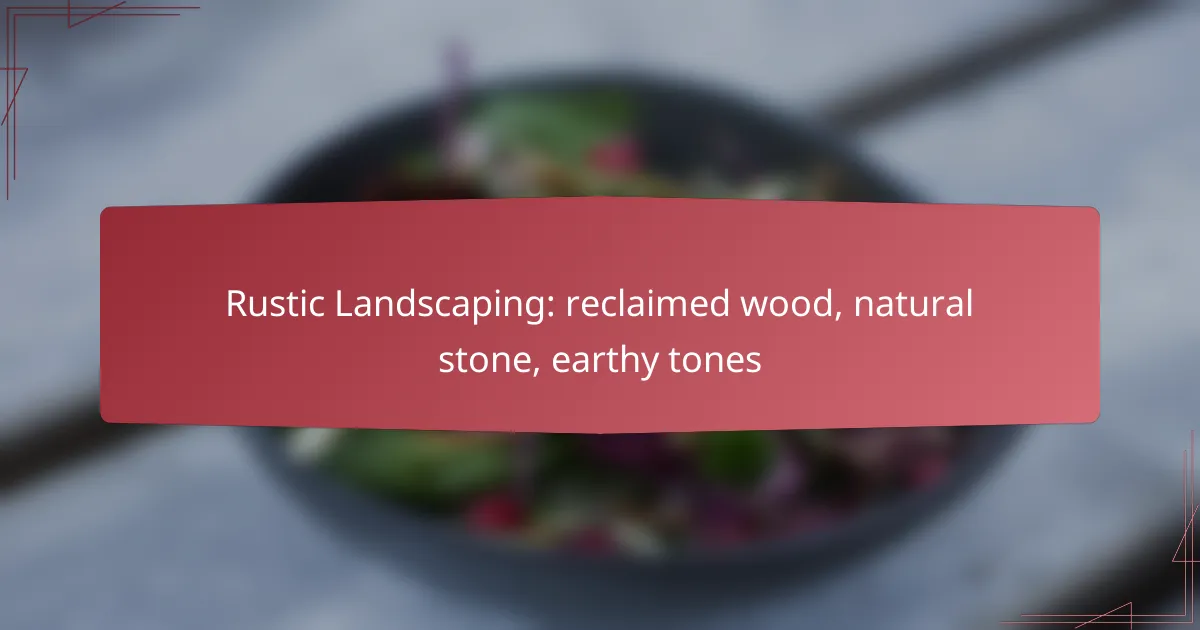Mediterranean landscaping beautifully combines terracotta tiles, olive trees, and warm colors to create inviting outdoor spaces. The earthy tones of terracotta tiles enhance the aesthetic while providing practicality, while olive trees add a unique charm and thrive in dry conditions. Warm hues like ochre and soft yellows evoke the sun-drenched essence of the Mediterranean, resulting in a vibrant and welcoming atmosphere.

How to incorporate terracotta tiles in Mediterranean landscaping?
Incorporating terracotta tiles in Mediterranean landscaping involves using their earthy tones and textures to create a warm, inviting atmosphere. These tiles are not only aesthetically pleasing but also practical for outdoor settings, enhancing the overall design of your space.
Durability and weather resistance
Terracotta tiles are known for their durability and ability to withstand various weather conditions. They are fired at high temperatures, making them resistant to cracking and fading, even in sunny climates typical of Mediterranean regions. However, it’s essential to seal them properly to prevent moisture absorption and staining.
When selecting terracotta tiles, consider those with a higher density for better weather resistance. Tiles rated for outdoor use will typically last longer and maintain their appearance despite exposure to rain and sun.
Color options and design versatility
Terracotta tiles come in a range of warm colors, including reds, oranges, and browns, which complement the natural landscape of Mediterranean gardens. These hues can be mixed and matched to create unique patterns or laid in traditional formats for a classic look.
Additionally, terracotta can be paired with other materials, such as stone or wood, to enhance design versatility. Consider using decorative tiles as accents to add visual interest to pathways or patios.
Installation techniques for outdoor spaces
Proper installation of terracotta tiles is crucial for longevity and performance. Start by preparing a stable base, ensuring it is level and well-drained to prevent water pooling. A sand or gravel base is often recommended for outdoor applications.
When laying the tiles, use a thin-set mortar suitable for outdoor use. Leave appropriate grout lines to allow for expansion and contraction. Finally, apply a sealant after installation to protect against moisture and stains, ensuring your tiles remain vibrant and intact for years to come.

What are the benefits of using olive trees in landscaping?
Olive trees offer numerous advantages for landscaping, including their low maintenance requirements and ability to thrive in dry conditions. Their unique aesthetic and environmental benefits make them a popular choice for Mediterranean-inspired gardens.
Low maintenance and drought resistance
Olive trees are renowned for their low maintenance needs, requiring minimal watering once established. They are well-suited for regions with hot, dry summers, making them ideal for Mediterranean climates where water conservation is essential.
These trees can survive on limited rainfall, making them a sustainable choice for landscaping. Regular pruning and occasional fertilization are typically all that is needed to keep them healthy and thriving.
Year-round aesthetic appeal
Olive trees provide year-round beauty with their silvery-green leaves and gnarled trunks, adding character to any landscape. In spring, they produce small, fragrant flowers, while their fruit offers visual interest in late summer and fall.
Their unique shape and color contrast beautifully with terracotta tiles and warm-colored stones, enhancing the overall Mediterranean theme. This enduring appeal ensures that gardens remain vibrant throughout the seasons.
Environmental benefits and carbon sequestration
In addition to their aesthetic value, olive trees contribute positively to the environment by sequestering carbon dioxide. This helps mitigate climate change by reducing greenhouse gases in the atmosphere.
Furthermore, they provide habitats for various wildlife, promoting biodiversity in landscaped areas. Planting olive trees can also improve soil health and prevent erosion, making them a beneficial addition to any garden design.

What warm colors are best for Mediterranean landscapes?
Warm colors such as terracotta, ochre, and soft yellows are ideal for Mediterranean landscapes. These hues evoke the sun-drenched environment typical of the region, creating a welcoming and vibrant atmosphere.
Popular warm color palettes
Common warm color palettes for Mediterranean landscaping include combinations of earthy tones like terracotta, sandy beige, and golden yellows. Pairing these with accents of deep reds or burnt oranges can enhance the overall warmth and richness of the space.
Consider using a palette that reflects the natural surroundings, such as olive greens alongside warm neutrals. This approach not only harmonizes with the landscape but also creates a cohesive aesthetic.
Impact on mood and ambiance
Warm colors significantly influence mood, promoting feelings of comfort and relaxation. In Mediterranean landscapes, these hues can create an inviting environment that encourages outdoor living and social gatherings.
Additionally, warm colors can enhance the perception of space, making areas feel more expansive and open. This is particularly effective in outdoor settings where light plays a crucial role in the overall ambiance.
Complementary plant choices
To complement warm color palettes, consider planting species that thrive in Mediterranean climates, such as lavender, rosemary, and bougainvillea. These plants not only add vibrant colors but also provide delightful fragrances that enhance the outdoor experience.
Incorporating olive trees can further reinforce the Mediterranean theme while offering shade and structure. Their silvery leaves contrast beautifully with warm tones, creating a visually appealing landscape.

What are the key design principles for Mediterranean landscaping?
Mediterranean landscaping emphasizes harmony with nature, utilizing local materials and colors that reflect the region’s warm climate. Key principles include the use of natural elements, outdoor living spaces, and water features to create a serene and inviting environment.
Focus on natural materials
Utilizing natural materials is essential in Mediterranean landscaping. Terracotta tiles, stone, and wood not only enhance aesthetic appeal but also blend seamlessly with the surrounding environment. These materials are durable and can withstand the region’s climate, making them practical choices.
When selecting materials, consider local options to reduce transportation costs and environmental impact. For example, using locally sourced stone can add authenticity and character to your landscape.
Creating outdoor living spaces
Outdoor living spaces are a hallmark of Mediterranean design, promoting a lifestyle that embraces the outdoors. Patios, terraces, and pergolas provide areas for relaxation and socializing, often adorned with comfortable furniture and vibrant plants.
To create an inviting outdoor space, incorporate elements like shade structures, outdoor kitchens, and dining areas. Use warm colors in furnishings and decor to reflect the Mediterranean palette, enhancing the overall atmosphere.
Incorporating water features
Water features play a vital role in Mediterranean landscaping, providing both aesthetic appeal and a cooling effect. Fountains, ponds, and pools can create a tranquil ambiance while attracting wildlife and enhancing biodiversity.
When designing water features, consider their scale and placement. A small fountain can serve as a focal point in a garden, while a larger pool can become a central gathering space. Ensure that the materials used for these features harmonize with the overall landscape design.

How to choose the right plants for a Mediterranean garden?
Choosing the right plants for a Mediterranean garden involves selecting species that thrive in warm, dry climates and can withstand drought. Focus on native plants, seasonal bloomers, and appropriate height and spacing to create a vibrant and sustainable landscape.
Native plant selections for climate adaptation
Native plants are well-suited for Mediterranean climates, as they have adapted to local conditions over time. Consider species like lavender, rosemary, and olive trees, which require minimal water and can endure heat. These plants not only thrive but also support local wildlife and biodiversity.
When selecting native plants, prioritize those that are drought-resistant and have low maintenance needs. This approach reduces water consumption and ensures your garden remains lush during dry spells.
Seasonal blooming considerations
In a Mediterranean garden, seasonal blooming is essential for maintaining visual interest throughout the year. Choose plants that flower at different times, such as bougainvillea in summer and cyclamen in winter. This staggered blooming provides color and texture across the seasons.
Plan your garden layout to include early, mid, and late bloomers. This strategy ensures that your garden remains vibrant and inviting, attracting pollinators and enhancing the overall aesthetic.
Plant height and spacing strategies
When designing your Mediterranean garden, consider the height and spacing of plants to create a balanced look. Taller plants, like olive trees, should be positioned at the back or center, while shorter plants, such as herbs and ground covers, can fill in the front. This arrangement allows for visibility and accessibility.
A general guideline is to space plants according to their mature size, typically 1 to 3 feet apart, depending on the species. Proper spacing promotes air circulation and reduces competition for nutrients, leading to healthier plants.

What are the costs associated with Mediterranean landscaping?
The costs of Mediterranean landscaping can vary significantly based on materials, design complexity, and location. Key elements like terracotta tiles, olive trees, and warm color palettes influence overall expenses, typically ranging from a few thousand to tens of thousands of dollars depending on the project scope.
Average pricing for terracotta tiles
Terracotta tiles are a popular choice for Mediterranean landscaping due to their durability and aesthetic appeal. On average, the cost for terracotta tiles can range from $5 to $15 per square foot, depending on quality and design. Installation costs may add an additional $3 to $10 per square foot.
When selecting terracotta tiles, consider factors such as thickness, finish, and whether they are handmade or mass-produced. Handmade tiles, while often more expensive, can provide unique character and charm to your landscape.
To optimize your budget, compare prices from multiple suppliers and consider purchasing in bulk. Additionally, check for seasonal sales or discounts that can help reduce overall costs.



